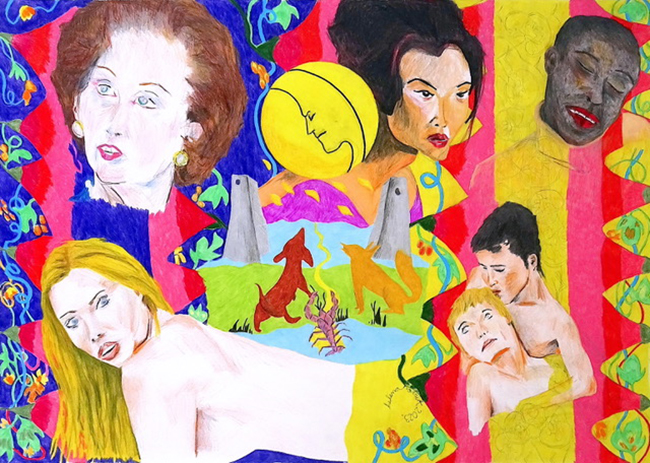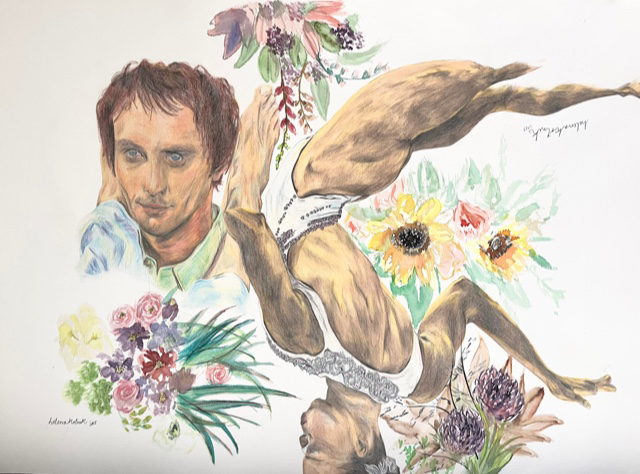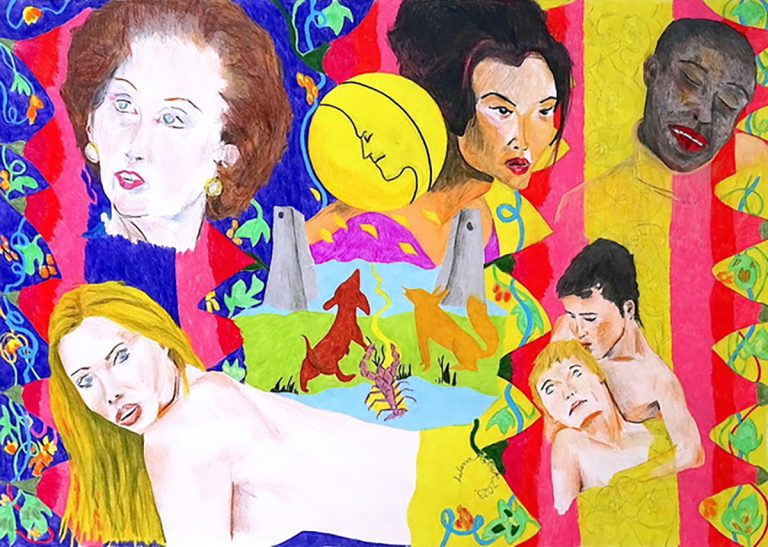Helena Kotnik, who studied at Barcelona University and the Akademie der bildenden Künste in Vienna, creates art that feels like a conversation between color and consciousness. Her paintings, often described as “psychological human landscapes,” explore how we move through the unseen spaces of emotion and thought. Working in a style that’s both vivid and deceptively simple, she uses color and gesture to explore what lies beneath human behavior—the humor, chaos, and tenderness that define us. Drawing inspiration from artists across many eras, Kotnik’s work becomes a kind of visual reflection, showing us our shared contradictions and quiet strengths. Through her art, she translates the rhythm of life into something visible, a reminder that the human experience is layered, fragile, and deeply alive.
Women (2025, 70x50cm, Pencil colors)

In Women, Kotnik paints femininity as a state of constant transformation. The drawing feels alive—vibrant, restless, and full of stories that overlap and breathe together. Each curve, each burst of color, seems to hold a fragment of lived experience. Rather than define womanhood, Kotnik allows it to expand—open, undefended, and infinitely complex.
The work glows with rich hues that hum with energy. Reds, yellows, and blues collide, not in conflict but in conversation. The use of colored pencil gives a tactile quality to the surface, as if the artist’s hand never fully left the paper. Beneath the apparent simplicity lies a sense of intuition; emotion drives the drawing more than logic.
Kotnik doesn’t offer an idealized image of women. Instead, she presents a tapestry of existence—women as creators, observers, thinkers, and dreamers. The overlapping tones and shapes evoke a rhythm that feels musical, cyclical, and deeply human. There’s a harmony between chaos and calm, an understanding that both belong to the feminine experience.
The figures, whether clearly defined or abstractly hinted, are interconnected. They share space rather than compete for it, forming a collective presence. This interconnectedness becomes the central theme of the work: femininity as shared resilience. Kotnik portrays womanhood as a dialogue across time and feeling, not a solitary act.
While the colors celebrate vitality and movement, there’s also a reflective undercurrent. The brightness holds depth—an acknowledgment of the quiet struggles that shape strength. The result is an artwork that balances lightness with gravity. Women doesn’t declare empowerment; it embodies it. It honors the act of simply continuing, of carrying one’s self and others through the everyday.
Through this piece, Kotnik elevates drawing itself into a form of meditation. The layering of color and gesture becomes an act of care, a quiet assertion that art can heal, reveal, and connect.
On-tempo (2025, 100x70cm, Pencil colors and watercolor)

If Women speaks in many voices, On-tempo listens inwardly. It’s about rhythm—the steady pulse of being present. The painting feels like a breath held and released. The title hints at the idea of moving at one’s own pace, finding synchronicity without rushing to match the world’s tempo.
In this work, Kotnik combines the precision of colored pencil with the fluidity of watercolor. The dialogue between these materials mirrors the balance between structure and surrender. Watercolor flows freely, unpredictable, while pencil defines and guides it. The outcome is a surface that moves gently between clarity and blur, like thought shifting into feeling.
The painting doesn’t tell a story; it creates a state of awareness. Each color seems to arrive with intention, then dissolve softly into silence. There’s motion, but it’s not hurried. It’s a kind of stillness in motion—the visual equivalent of mindfulness.
Kotnik’s written reflection—“Moving in rhythm with your own timing instead of rushing or grabbing to meet others… staying on tempo then means adapting, not resisting”—feels deeply embedded in this piece. The painting invites the viewer to slow down, to see how life can unfold with ease when one listens instead of pushes.
Even the negative space feels alive, as if the air around the forms carries weight and meaning. Every pause between colors is deliberate, like the rests in a piece of music. Through this careful pacing, Kotnik captures the essence of balance: the art of moving and pausing without losing one’s rhythm.
The tone is quiet but grounded. On-tempo doesn’t demand attention—it earns it through calm presence. It’s a painting that teaches through feeling rather than message. In a world obsessed with speed, Kotnik’s work becomes an act of resistance—a gentle insistence on presence and patience.
Together, Women and On-tempo reveal Helena Kotnik’s gift for turning emotion into movement. Her art doesn’t aim to explain life; it synchronizes with it. Through color, rhythm, and reflection, she reminds us that to create—and to live—is to stay aware of one’s own tempo, to keep breathing through the noise, and to remain open to the unseen music of being human.

